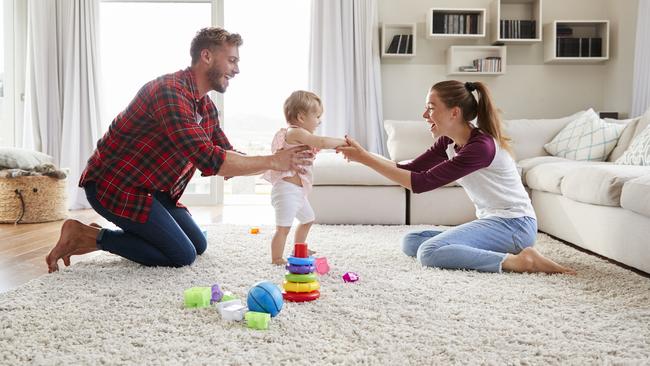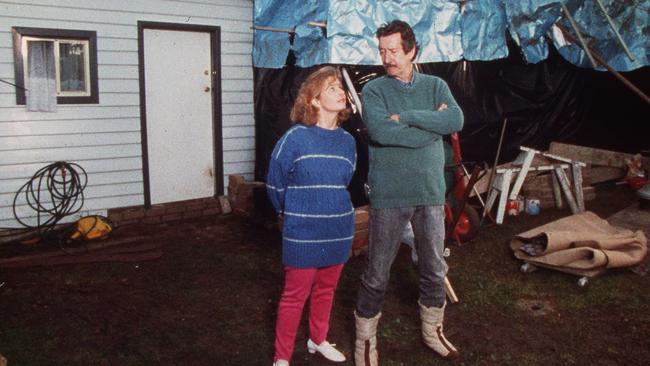Millennial’s toddler-inspired suburban switcheroo: Creating the People’s Demographic Republic of 45


Be it beloved or be it be-loathed a sprawling realm of separate houses on separate blocks of land is the stuff that (spiritually) connects all Australians. After all, who isn’t inspired by Darryl Kerrigan and his commitment to his humble suburban castle?
But Aussies should be aware that this place, this “suburbia” is about to be made over by a demographic force that is now marshalling for an invasion.
The force that will surely transform our suburban heartland is none other than the millennial generation born 1983-2001, the now (in 2024) 23-41 year-old children of baby boomers born 1946-1964 (now aged 60-78).
New population projections published by the Australian Bureau of Statistics in November show by single year of age the transformations we can expect over the decade to 2033.
At an aggregate (medium) level, the outlook is for net growth of 3.3 million or 14 per cent to 30.3 million by 2033. Personally, I think the actual figure will be a tad higher at around 31 million by this year.
Over the coming decade the millennial generation that famously (from a property point of view) colonised the inner city as singles and couples over the past 15 years will transition into the growing family stage of the life cycle. This transition is evident in a single figure buried deep within the ABS data.
In 2023, the number of Australians aged 45 (gen Xers, born 1978) was estimated at 319,000. By 2033, Australia’s 45-year-old population (millennials, born 1988) is projected to be 411,000. Over the coming decade Australia’s 45-year-old population will ramp-up at a rate of 9000 a year or of 3 per cent a year.
Forget about the Gold Coast going gangbusters at 2 per cent growth per year. The newest, the latest, the coolest demographic hotspot on the Australian continent is the People’s Demographic Republic of 45.
And the reason why 45 is so important is because the property world looks different from a vantage point of this age than it does from a vantage point of 35. I will explain why later.

An entire five-plus-million cohort of now-marshalling, indeed of now-milling, millennials hovering on the windward side of 40 spells trouble (with a capital T) for Australian planners.
And here’s the reason.
Up until the ABS released their latest projection series, millennials and the strategic planning bureaucracy were aligned in their thinking: densification is required to save the planet therefore we need high-rise towers in the inner city and within walking distance of transportation hubs. Cities need to be contained within an existing urban footprint.
City growth via greenfields developments must be constrained at all costs.
Single and couple millennials in their 20s and 30s very much concurred with this logic. And so too did many within the property industry.
The suburbs were eschewed (by some) in favour of chic, sophisticated minimalist apartments – that took on the hue of a five-star hotel – and that were positioned in the inner city close to knowledge-worker jobs.
All this logic worked a treat from, say, the time of the GFC (2008) right up until the start of the post-pandemic era (2023) as the top end of the millennial generation started to pass into their 40s.
By the age of 40, millennials begin to move into the family stage of the life cycle, which is when babies and then toddlers arrive in the family home.
It is technically possible to retain a veneer of minimalism and spotlessness when a couple have a baby, but that veneer vanishes when babies transition into toddlers. And it is the toddler cohort that is tipping millennial parents inexorably towards the suburbs.
And so, all of a sudden, it’s out with apartmentia and in with suburbia. Or at least in with a modern (tricked-up) version of suburbia featuring the lifestyle home: front yard, backyard, four bedrooms, two bathrooms, Zoom Room(s), and a kitchen that looks a bit like a cafe.
Espresso anyone?
The language shifts. New ideas of how to live emerge or, more likely, old ideas get a groovy makeover. Time to address the missing middle. Work from home becomes a right. Four-day week (and its alphanumeric acronym 4DW) anyone?
Here is a switch in thinking and behaviour that mid-career strategic planners might be a tad concerned about.
A critical mass of the Middle Australia (ie millennials) moving into the family-stage of the life cycle (say 2023-2033) desperately seeking living space and affordability might actually prefer a separate house on a separate block of land in middle- or even in outer-suburbia.
Or even more confronting, this generation – previously an ally of inner-city densification – might start demanding more lifestyle homes (aka McMansions) in the lifestyle zones (seachange, treechange) attached to the edges of capital cities.
That an element of the market might now prefer to live in a lifestyle home in the suburbs normally wouldn’t be a sufficient basis to alter strategic plans. After all, demographic cohorts come and go.

However, 40-something millennials on the march – as proven by the ABS – in search of affordable lifestyle homes on and beyond the urban fringe have what I think is a compelling argument for the release of more greenfields residential land. And that is the post-Covid workplace revolution that is now playing havoc with the office market.
Do I have your attention now?
Strategic planning must now reflect new behaviours and preferences.
Traditionally strategic planners would argue that it is bad policy to support growth on the urban fringe because it places too much pressure on transportation infrastructure.
And politicians, ever anxious not to be put under pressure to deliver infrastructure inevitably agree with a “sweat the assets” approach leading to densification of the existing urban footprint including the so-called missing middle.
But the advent of a 4DW will reduce commuting traffic by up to 20 per cent, will it not? Plus, hybrid working (includes WFH) also reduces the incidence of commuting.
The results of the 2026 Census (likely released November 2027) will reveal the extent of the structural impact of WFH (and of the 4DW) which I think will show a 10 percentage-point uplift in the overall proportion of workers working from home over and above the number that was recorded in 2016 (ie 5 per cent).
This uplift will be higher in large capital cities like Melbourne and Sydney and greatest on the urban fringe.
Surely strategic planners will be delighted in any (long-term) reduction in the proportion of workers commuting. This shift would then support the delivery of more greenfields residential land to meet the lifestyle requirements and preferences of millennials in the family stage of the life cycle.
The pandemic forced borders closed, required workers to work from home, encouraged Australians to learn new technology such as QR codes and apps. All these changes occurred at a time of the baby bust prompting and accentuating a skills shortage.
These events and more have created a sense of change within Australia and beyond.
It’s time now to boldly imagine how we want to live and work as a nation. The idea of unrelenting commuting is anathema to Australians; new options will be found regardless of what the property industry might prefer.
One of those options is the idea of creating more active local communities based around workers who partly, perhaps even who predominantly, work from home. If this is the case then the home must change.
The apartment was perfect for young singles and couples. It still is. But the new breed of 40-something parents will require something different, something that I think will be known as the lifestyle home.
Here is a concept whose time wasn’t so much over the past 20 years; its time is the next 10 years. As homely and as happy as Darryl Kerrigan’s “castle” was, I doubt it would suit modern millennial 40-somethings with kids pressing towards the teenage years.
As we increasingly work, study, shop and watch Netflix from home, the functionality of the home must change. And so too must its scale, its sense of value and its location. Leave the inner city for single and couple gen-Zeds and for downshifting Xers and boomers.
After re-crafting the inner city in their own style over the past 15 years, it’s time for the millennials to do a bit of a switcheroo (with their toddlers in tow) and to re-craft the great Australian suburbia into bespoke, family-friendly, a-bit-groovy lifestyle zones.
Bernard Salt is founder of The Demographics Group; data in collaboration with Sarah Read







It is the heart and soul of Australia. It is the 20th century’s answer to the 19th century’s billy tea. It is the habitat known as the three-bedroom brick-veneer and which collectively and lovingly constitutes our heartland, our homeland, the great Australian suburbia.